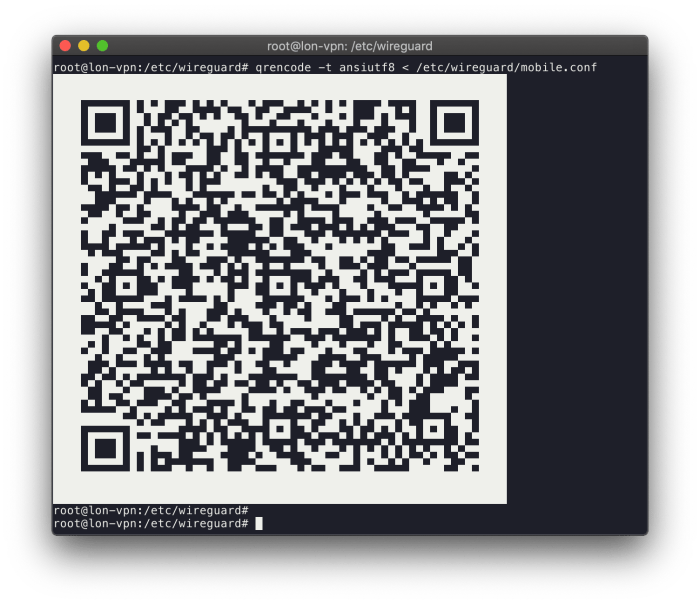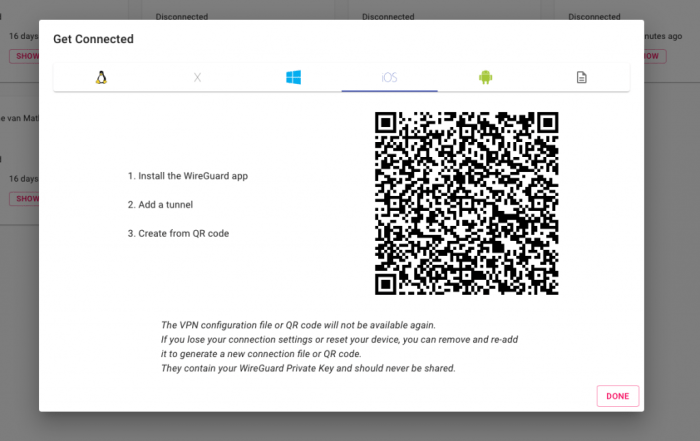In the realm of virtual private networks (VPNs), WireGuard stands out as a cutting-edge tunneling protocol that prioritizes speed, security, and ease of use. Its innovative approach to VPN configuration has revolutionized the way we establish secure connections over the internet.
One of the key features that sets WireGuard apart is the ability to generate QR codes for quick and effortless configuration.
QR codes, or Quick Response codes, have become ubiquitous in our digital lives, allowing us to access information and perform actions with a simple scan. By incorporating QR code generation into WireGuard, users can bypass the complexities of manual configuration and enjoy a seamless and error-free setup process.
In this comprehensive guide, we will delve into the world of WireGuard QR codes, exploring their benefits, use cases, and best practices.
Introduction

WireGuard is a modern and secure VPN (Virtual Private Network) protocol that provides a fast, reliable, and privacy-focused way to establish encrypted connections over the internet.
Generating QR codes for WireGuard configurations simplifies the process of sharing and deploying WireGuard setups. By scanning the QR code with a compatible app, users can automatically import the necessary configuration details into their devices, eliminating the need for manual configuration.
Benefits of Using QR Codes for WireGuard
- Simplified configuration: QR codes eliminate the need for manual configuration, reducing errors and saving time.
- Enhanced security: QR codes provide a secure way to share WireGuard configurations, minimizing the risk of unauthorized access or eavesdropping.
- Cross-platform compatibility: QR codes can be scanned using a wide range of devices and operating systems, ensuring compatibility with various platforms.
- Convenient deployment: QR codes can be easily printed or distributed electronically, making it convenient to deploy WireGuard configurations to multiple users.
Generating QR Codes
Generating a QR code for a WireGuard configuration simplifies the process of sharing and deploying the configuration, allowing devices to connect to the VPN with a simple scan.
To generate a QR code, you will need:
- A WireGuard configuration file (.conf)
- A QR code generator (online or software-based)
Steps to Generate a QR Code
- Open the WireGuard configuration file (.conf) and locate the following sections:
- [Interface]
- [Peer]
- Copy the contents of these sections, including the keys and addresses.
- Paste the copied text into the QR code generator.
- Generate the QR code.
The generated QR code can be scanned using a QR code reader app on a mobile device to automatically import the WireGuard configuration and connect to the VPN.
Scanning QR Codes

Scanning a WireGuard QR code with a mobile device is a convenient way to configure the WireGuard client on your device. Here’s how you can do it:
Once you have scanned the QR code, the WireGuard client will automatically import the necessary configuration settings. You may need to confirm the import and provide additional information, such as a password or passphrase, if required.
Confirming the Import
- After scanning the QR code, the WireGuard client will display a confirmation dialog.
- Review the configuration settings to ensure they are correct.
- If everything looks good, tap on the “Confirm” button to import the settings.
Providing Additional Information
- In some cases, the WireGuard client may require you to provide additional information, such as a password or passphrase.
- Enter the required information and tap on the “OK” button.
Benefits of Using QR Codes
Leveraging QR codes for WireGuard configuration offers a multitude of advantages. Primarily, it simplifies the setup process, making it effortless for users to establish secure connections.
QR codes eliminate the need for manual entry of complex configuration parameters, reducing the likelihood of errors. By simply scanning the QR code, users can automatically configure their WireGuard clients, ensuring accurate and seamless connectivity.
Enhanced Security
- QR codes provide an additional layer of security by eliminating the risk of human error during manual configuration.
- The encrypted information stored within the QR code ensures the integrity of the configuration data.
Increased Accessibility
- QR codes make it easy for users to share and distribute WireGuard configurations with others.
- By scanning the QR code with a smartphone or tablet, users can quickly and conveniently connect to the WireGuard network without the need for additional software or complicated instructions.
Time-Saving
- QR codes significantly reduce the time required to configure WireGuard clients.
- By eliminating the need for manual entry, users can save valuable time and effort, allowing them to focus on other important tasks.
Best Practices
Generating and scanning WireGuard QR codes securely and efficiently requires adhering to certain best practices.
To ensure the integrity and confidentiality of your WireGuard configurations, consider the following guidelines:
Security Considerations
- Use strong passwords: Generate complex and unique passwords for your WireGuard configurations. Avoid using easily guessable or common phrases.
- Protect your QR codes: Keep your WireGuard QR codes private and do not share them with untrusted parties. Store them securely on your personal devices.
- Disable QR code sharing: If possible, disable the option to share QR codes with others on your device to prevent unauthorized access.
- Use a dedicated QR code reader: Employ a reputable QR code reader app to scan WireGuard QR codes, ensuring it is from a trusted source.
- Verify QR code authenticity: Before scanning a WireGuard QR code, visually inspect it for any suspicious elements or alterations. Confirm its legitimacy with the intended sender.
Scanning Best Practices
- Scan QR codes in a secure environment: Avoid scanning QR codes in public or untrustworthy locations where your device may be compromised.
- Use a reliable QR code reader: Employ a well-known and trusted QR code reader app to ensure accurate scanning and protection against malicious codes.
- Check permissions before scanning: Review the permissions requested by the QR code reader app before granting access to your device.
- Manually enter the configuration: If possible, manually enter the WireGuard configuration details instead of scanning a QR code to minimize potential security risks.
Troubleshooting
Generating or scanning WireGuard QR codes can occasionally encounter issues. This section addresses common problems and provides troubleshooting steps to resolve them.
If you experience difficulties, refer to the following sections for guidance on resolving the specific issue you encounter.
QR Code Generation Issues
- QR code not generated: Ensure that you have entered all required fields correctly and that your device is connected to the internet.
- QR code blurry or unreadable: Try increasing the resolution of the QR code or using a different QR code generator.
QR Code Scanning Issues
- QR code not recognized: Ensure that your device has a QR code scanner app installed and that the camera is properly focused on the QR code.
- Invalid QR code: Verify that the QR code was generated correctly and that it has not been altered or damaged.
Use Cases

Generating WireGuard QR codes offers practical benefits in various scenarios, making it an efficient tool for network management.
One of the key use cases is streamlining VPN deployment. By providing a QR code, network administrators can simplify the process of onboarding new devices onto the VPN, reducing the risk of errors and ensuring secure remote access.
Device Onboarding
- QR codes eliminate the need for manual configuration, reducing errors and saving time.
- Users can simply scan the QR code using a compatible app, automatically configuring their devices with the necessary VPN settings.
- This method is particularly useful for large-scale device deployments or when dealing with non-technical users.
Advanced Options
In addition to the basic options, WireGuard QR code generation offers advanced features for customizing the appearance and including additional information.
Customizing QR Code Appearance
- Color Customization: Change the colors of the QR code’s background, foreground, and border to match your branding or preferences.
- Logo Integration: Embed your company logo or other relevant imagery within the QR code for enhanced brand recognition.
- Shape Modification: Choose from various shapes for your QR code, such as square, circle, or rectangle, to suit your design aesthetic.
Including Additional Information
You can add additional information to the QR code, such as:
- Contact Details: Include your website, email address, or phone number to provide more ways for users to connect with you.
- Social Media Links: Link to your social media profiles to encourage followers and build your online community.
- Custom Text: Add a brief message or call-to-action to guide users after they scan the QR code.
Integration with Other Tools
Integrating WireGuard QR code generation with other tools offers a range of benefits, enabling automation and seamless incorporation into existing workflows.
By automating the QR code generation process, you can streamline tasks and save time. For instance, you can integrate with a password manager to automatically generate QR codes for WireGuard configurations stored within the manager.
Custom Scripts
Custom scripts can be developed to generate WireGuard QR codes programmatically. These scripts can be tailored to specific needs, such as generating codes based on predefined templates or incorporating additional data into the QR code.
Cloud Services
Cloud services provide a convenient and scalable platform for QR code generation. By integrating with cloud services, you can access advanced features such as bulk generation, storage, and sharing of QR codes.
Future Trends
The future of WireGuard QR code generation holds exciting prospects. As technology advances, we can expect to see new applications and advancements in this area.
One potential trend is the integration of artificial intelligence (AI) into QR code generation. AI can help automate the process of creating and managing QR codes, making it easier and more efficient for users.
Advanced Security Features
As security threats continue to evolve, we can expect to see QR codes with advanced security features. These features could include encryption, authentication, and tamper-proof mechanisms, making QR codes even more secure and reliable.
Integration with Mobile Devices
QR codes are already widely used on mobile devices, and this trend is likely to continue. In the future, we can expect to see even more integration between QR codes and mobile apps, making it easier for users to scan and use QR codes.
Cross-Platform Compatibility
As the use of QR codes becomes more widespread, we can expect to see increased cross-platform compatibility. This means that QR codes will be able to be scanned and used on a variety of devices, regardless of operating system or platform.
Last Point
As we navigate the ever-evolving landscape of cybersecurity, WireGuard QR codes emerge as a valuable tool for securing our online presence. Their simplicity, security, and versatility make them an indispensable asset for anyone seeking to establish reliable and private VPN connections.
Whether you’re a seasoned IT professional or a novice user, embracing WireGuard QR codes will streamline your VPN configuration process, enhance your security posture, and empower you to harness the full potential of this remarkable VPN protocol.